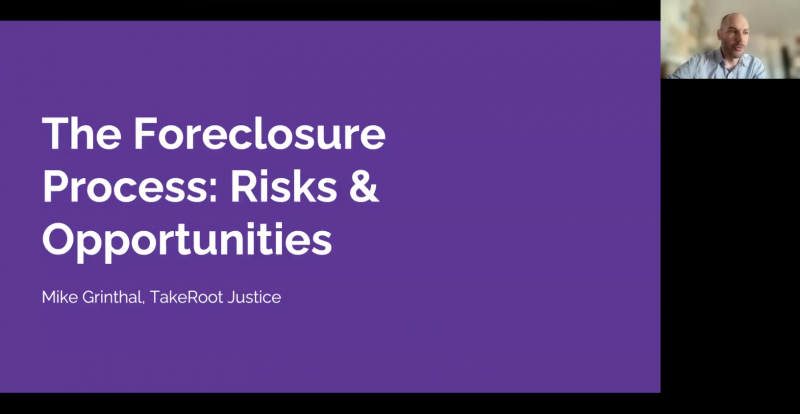
When a building goes into foreclosure, tenants are often left in the dark about what it means for their homes, rights, and future. A recent presentation by Mike Grinthal of TakeRoot Justice sheds light on how the foreclosure process unfolds in New York City—and, importantly, how tenants can organize and protect themselves along the way.
Why This Matters
Foreclosure can be disorienting, but tenants are not powerless. With the right tools—legal responses, collective organizing, and strategic motions—renters can influence repairs, ensure accountability, and protect our rights throughout the process.
Watch the recording and view the presentation slides.
How Foreclosure Starts
The process begins when a mortgage-holder files a summons and complaint in the Supreme Court (Commercial Division) in the borough where the building is located. Defendants typically include the property owner, city agencies, lenders, and tenants—who are usually listed as “John or Jane Doe.”
Tenants must receive a Notice of Foreclosure, which is posted in the building.
Tools for Research
Tenants and advocates can follow the progress of cases online:
- NYSCEF (New York State Courts Electronic Filing System): Offers access to scanned court papers (requires an account).
- E-Courts: Provides case schedules, judges, and index searches (no account needed).
Tenants’ Role in the Case
Although tenants are rarely the direct target of foreclosure claims, they can:
- File an answer to bring building conditions to the court’s attention.
- Request judicial intervention (RJI) to push the case forward if it’s stalled.
- Seek the appointment of a receiver, who temporarily manages the building.
How Does a Receiver Affect Strategy?
A receiver replaces the landlord during foreclosure. They collect rent, renew leases, make repairs (when funds allow), and report to the judge. Tenants should only pay rent to the receiver once an official court order is received.
Receivers shift the strategy. As a target of organizing, they’re not influenced by rent strikes since they’re paid by the court, but they can be pressured through legal motions.
Securing Funds for Repairs
Tenants can advocate for building repairs through:
- Milbank Motions: Asking the judge to order the lender to deposit money for emergency repairs (a precedent was set in 2009 with $2.5M granted for Bronx buildings).
- RPAPL 1307 (2021 Amendment): Requires mortgage-holders to maintain abandoned but occupied properties, unless a receiver is already appointed.
Sale and Aftermath
Once foreclosure is finalized:
- A referee calculates what’s owed.
- The building is sold at auction.
- Sale proceeds go first to court costs and the receiver, then to lenders and creditors, and finally to the owner (if anything remains).
Impact on Tenants
- Rent-regulated and federally subsidized tenants: Protected; leases continue.
- Unregulated leases: Valid if signed before foreclosure, but canceled if signed during the case.
- Month-to-month tenants: Can be evicted with 90 days’ notice.
Bankruptcy Twist
If the owner files for bankruptcy, the foreclosure is frozen, receivers lose authority, and control shifts to a trustee appointed by the bankruptcy court—who may also sell the building.
The Importance of Organizing
The foreclosure process is complex and daunting. But when tenants organize together, we stand a much better chance of winning better living conditions and staying in our homes.
To educate yourself more about the process, watch the recording and view the presentation slides. And if you live in the Lower East Side or East Village, reach out to us at Cooper Square Committee for help organizing with your neighbors!
